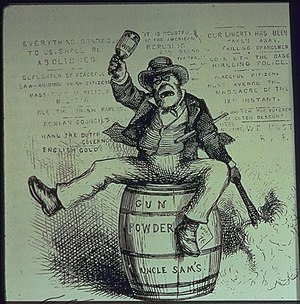This is an old revision of this page, as edited by Manopingo (talk | contribs) at 04:39, 13 March 2007 (rormat). The present address (URL) is a permanent link to this revision, which may differ significantly from the current revision.
Revision as of 04:39, 13 March 2007 by Manopingo (talk | contribs) (rormat)(diff) ← Previous revision | Latest revision (diff) | Newer revision → (diff)
Anti-Irish racism includes persecution, discrimination, hatred or fear of the Irish as an ethnic or national group, whether directed against Ireland in general or against Irish immigrants in the diaspora. The term also applies to the religious persecution of Irish Roman Catholics.
Anti-Irish racism in Victorian Britain and 19th century United States included the stereotyping of the Irish as alcoholics, and implications that they monopolized certain (usually low-paying) job markets. Similar to other immigrant populations, they were sometimes accused of cronyism, and subjected to misrepresentations of their religious and cultural beliefs. Catholics were particularly singled out, and indigenous folkloric and mythological beliefs and customs were ridiculed.
Nineteenth century Protestant American "Nativist" prejudice against Irish Catholics reached a peak in the mid-1850s with the Know Nothing Movement, which tried to oust Catholics from public office. Much of the opposition came from Irish Protestants, as in the 1831 riots in Philadelphia, Pennsylvania. In rural areas in the 1830s riots broke out among rival labor teams from different parts of Ireland, and between Irish and "native" American work teams competing for construction jobs.
It was common for Irish people to be discriminated against in social situations, and intermarriage between Catholics and Protestants was uncommon (and strongly discouraged by both ministers and priests). One response to this prejudice was the creation of a parochial school system, in addition to numerous colleges, that isolated about half the Irish youth from the public schools. After 1860 many Irish sang songs about signs reading "HELP WANTED - NO IRISH NEED APPLY"; these signs came to be known as "NINA signs." These songs had a deep impact on the Irish sense of discrimination.

The 1862 song, "No Irish Need Apply", was inspired by NINA signs in London. Later the song was adapted by Irish Americans to include their experiences as well. The issue of job discrimination against Irish immigrants to America is a hotly debated among historians, with some insisting that the "No Irish need apply" signs so familiar to the Irish in memory were myths, and others arguing that not only did the signs exist, but that the phrase was also seen in print ads and that the Irish continued to be discriminated against in various professions into the 20th century.
Whether or not the signs ever existed in large numbers, many New Yorkers and other Americans harbored Nativist sentiment against the Irish Catholic poor in the post-Civil war period. Irish Americans were effectively barred from certain occupations. While the Irish dominated such occupations as domestic service, building, and factory work, they were not present in large numbers in the professions, finance, and other "white collar" businesses. In response, the Irish clung to their occupational niches fiercely, blocking attempts by newer immigrant groups and African Americans to enter them, and earning them a reputation for violence. Since many of the earliest late 19th century immigrant population was Irish, they received the first attacks and discrimination by Nativists and Protestants.
See also
References
- Wohl, Anthony S. (1990) "Racism and Anti-Irish Prejudice in Victorian England". The Victorian Web
- Hoeber, Francis W. (2001) "Drama in the Courtroom, Theater in the Streets: Philadelphia's Irish Riot of 1831" Pennsylvania Magazine of History and Biography 125(3): 191-232. ISSN 0031-4587
- Prince, Carl E. (1985) "The Great 'Riot Year': Jacksonian Democracy and Patterns of Violence in 1834." Journal of the Early Republic 5(1): 1-19. ISSN 0275-1275 examines 24 episodes including the January labor riot at the Chesapeake & Ohio Canal, the New York City election riot in April, the Philadelphia race riot in August, and the Baltimore & Washington Railroad riot in November.
- ^ Jensen, Richard (2002, revised for web 2004) "'No Irish Need Apply': A Myth of Victimization". Journal of Social History issn.36.2 pp.405-429
External links
This sociology-related article is a stub. You can help Misplaced Pages by expanding it. |
This Ireland-related article is a stub. You can help Misplaced Pages by expanding it. |